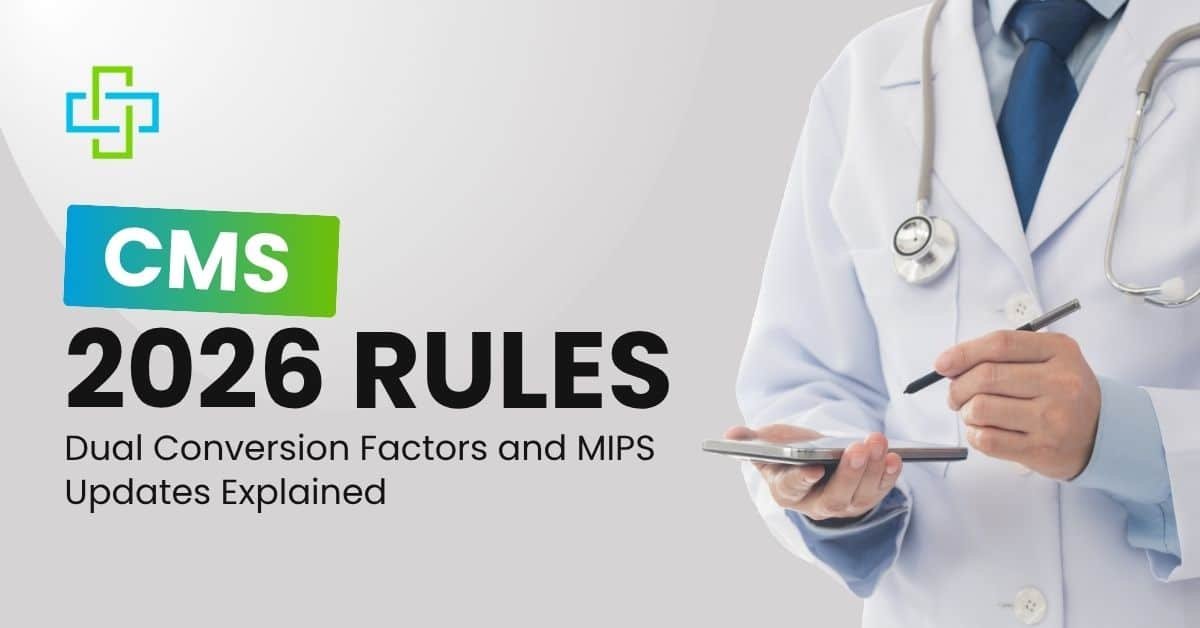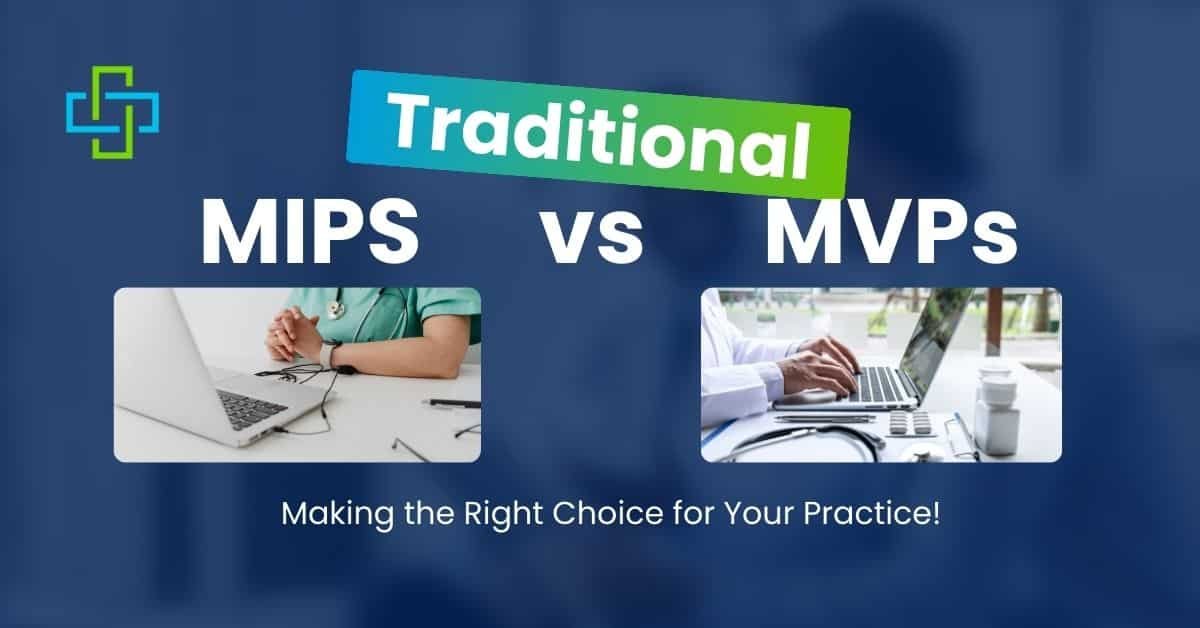The healthcare world is about to see some big changes. The CMS 2026 Rule just dropped, and doctors across the country are trying to figure out what it all means. If you’re feeling confused, it is all valid. Let’s break down this new rule in so you can understand how it affects your practice.
The biggest news from the CMS 2026 rule is something called dual conversion factors. Think of conversion factors as the multiplier CMS uses to calculate how much they pay you for each service. Until now, everyone has gotten the same rate. But starting in 2026, that changes.
Here’s the deal. The CMS 2026 rule is creating two different payment rates. Doctors who participate in quality programs like MIPS will get a higher conversion factor. Those who don’t participate will get a lower one. The difference might not sound huge at first, but when you add it up over thousands of patient visits, it could mean serious money.
This is CMS basically saying: “We’re serious about value-based care, and we’re putting our money where our mouth is.” If you’ve been sitting on the fence about whether to join these programs, this rule makes the decision a lot easier.
Changes Coming to MIPS
The Merit-Based Incentive Payment System is getting a makeover too. The QPP updates for 2026 are pretty significant. Let’s talk about what’s changing and what stays the same.
First off, CMS 2026 rule is asking for more detailed information. They want data at the individual provider level, not just practice-wide numbers. This means each doctor in your practice needs to show their own performance. It sounds like more work, but it makes sense. This way, high performers get credit for their good work, even if someone else in the practice isn’t doing as well.
The good news is that smaller practices are getting some relief. If you’re a small group, you won’t face some of the tougher requirements that larger organizations deal with. CMS seems to recognize that a three-doctor practice can’t operate the same way a hundred-doctor health system does.
Another change involves the measures you need to report. Some of the old measures that people complained about are going away. CMS listened to feedback and decided to retire measures that were either too complicated or didn’t really show much about the quality of care. That’s a win for everyone who’s been drowning in unnecessary paperwork.
The MVP Framework is Growing
If you haven’t heard about MIPS Value Pathways yet, pay attention. MVPs are becoming a bigger part of the picture. Think of them as pre-packaged sets of MIPS quality measures that make sense for your specialty. Instead of picking random measures from a giant list, you choose an MVP that fits what you actually do.
The CMS 2026 Rule is pushing MVPs even harder. For larger groups, there’s talk of requiring something called subgroup reporting within MVPs. This means different specialties within your practice might need to report separately. A cardiology group and a primary care group in the same organization would each show their own numbers.
For small practices, don’t worry. You’re protected from this requirement. But here’s some free advice: even if you don’t have to do it yet, start thinking about MVPs now. Getting familiar with this framework early will save you headaches down the road.
What About Shared Savings and APMs?
The Medicare Shared Savings Program and Alternative Payment Models are changing too. The CMS 2026 rule is pushing more practices toward what they call “two-sided risk.” This means you can earn bonuses if you save money and provide good care, but you might also face penalties if things don’t go well.
It’s scarier than one-sided risk, where you could only win, never lose. But the potential rewards are bigger. CMS is also testing out specialty-specific APMs. These are programs designed for particular types of doctors, not just primary care. If you’re a specialist, this could open new doors for you.
The message is clear. CMS wants everyone moving toward value-based care. The fee-for-service days are ending, whether we like it or not. The CMS 2026 Rule is just another step in that direction.
Why Working with a Registry Partner Makes Sense?
Let’s be honest. Most doctors didn’t go to medical school to become data reporting experts. You want to take care of patients, not spend your evenings wrestling with quality measures and submission deadlines.
This is where companies come in. A good registry partner handles the technical stuff so you can focus on medicine. They track your measures, make sure you’re reporting correctly, and help you avoid penalties while maximizing your bonuses.
Think of it like having a tax accountant. Sure, you could do your own taxes, but a professional knows all the rules, catches mistakes, and usually saves you more money than they cost. The same logic applies to MIPS reporting.
A partner that knows the QPP inside and out can spot opportunities you’d miss on your own. They can tell you which measures will score you the most points based on your patient population. They can flag problems before they become bigger issues. And they keep up with all the rule changes so you don’t have to.
With the CMS 2026 Rule making participation even more financially important, working with a MIPS registry expert isn’t just convenient anymore. It’s a smart business decision.
Getting Ready for 2026
So what should you do right now? First, don’t panic. You have time to prepare. But don’t wait until the last minute either.
Start by understanding where your practice stands today. Are you already participating in MIPS? If so, how are you scoring? If you’re not participating, calculate what the dual conversion factor difference would mean for your annual revenue. That number might surprise you.
Next, look at your current reporting process. Is it working well, or are you stressed every submission period? If it’s the latter, maybe it’s time to consider getting help from MIPS reporting company.
Talk to your team about the changes coming. Make sure everyone understands that quality reporting isn’t going away. It’s becoming more important every year. The practices that succeed will be the ones that build quality measurement into their daily workflow, not treat it as an annoying task they rush through at the deadline.
The Bottom Line
The CMS 2026 Rule represents a turning point. The days of ignoring quality programs and hoping they go away are over. The financial incentive for participation is now too big to ignore. The penalties for staying out are getting steeper.
But here’s the good news. If you take this seriously and get organized, you can come out ahead. Practices that embrace value-based care and invest in proper reporting strategies will thrive. Those who stick their heads in the sand will struggle.
The choice is yours. The CMS 2026 Rule is coming whether you’re ready or not. The question is whether you’ll see it as a threat or an opportunity.
Smart practices are already making their move. They’re evaluating their options, talking to registry partners, and building systems that will position them for success in this new payment environment. Don’t get left behind.
Start planning today, and 2026 will be a year of growth instead of stress. The CMS 2026 Rule might seem complicated, but with the right approach and the right help, you can turn these changes into wins for your practice and your patients.




